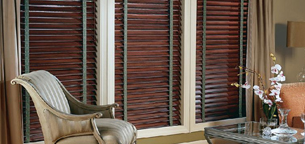Application Examples
Example 1:
A boardroom with a southern exposure
A boardroom contains a table which has been ruined due to a southern exposure which has badly faded one end of the table. The table has been replaced at considerable expense and to protect it, a smartBLIND system has been installed. Five south facing blinds are part of a single system. The sunlight sensor is located near the middle blind for optimum signal pickup. SENSOR Enable is ON and the system is set to high sensitivity so that only ambient sunlight can enter the room. In deference to environmental concerns the NIGHT CLOSE Enable is ON so that the blinds will close fully at night. This will prevent birds from flying into the boardroom windows at night.

A boardroom with a southern exposure
Example 2:
A corporate audiovisual room with 10 large windows
A corporate classroom has 10 large blinds which must be closed whenever audio-visual equipment is used during instruction. Since there are more than 6 blinds, two smartBLIND systems are required. The Command Unit for each system is located near the lecture podium so that the blinds can be quickly and conveniently closed when required. The SENSOR Enable is ON and because the classroom benefits from natural shading, the system sensitivity is set to low which means the blinds will only close partially in response to strong direct sunlight. This maintains an optimum and pleasant natural daylighting condition in the classroom at all times. NIGHT CLOSE Enable is ON so that the blinds will close fully at night. This reduces air conditioning costs for the facility and prevents the build-up of condensation on the interior of the windows. (Previously, at this facility, this problem occurred since the air conditioning vents are close to the windows. smartBLIND prevents this problem as the closed blinds do not allow cold air to make direct contact with the interior of the windows.)
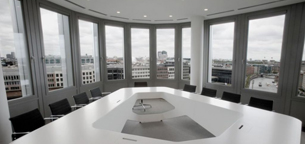
A corporate audiovisual room with 10 large windows
Example 3:
A boardroom receiving strong sunlight at some times of day
An executive boardroom is located in a building which is surrounded by other high-rises. Its location is such that strong direct sunlight can enter the room at peculiar times of the day due to reflections from other buildings. The room is shallow and has six large windows which means that the room will heat up quickly to an uncomfortable temperature. Since the room is used only for meetings, no one in the office thinks to close the blinds on sunny days and consequently the room is almost always very hot relative to the rest of the office. Setting the air conditioning in the office to a lower temperature to compensate causes the rest of the office to be uncomfortably cold and for energy costs to skyrocket.
The solution for this application is a single smartBLIND system. The SENSOR Enable is ON and the system sensitivity is set to medium. In deference to environmental concerns the NIGHT CLOSE Enable is ON so that the blinds will close fully at night. This will prevent birds from flying into the boardroom windows at night.
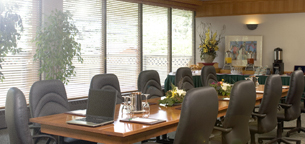
A boardroom receiving strong sunlight at some times of day
Example 4:
A coporate headquarters with an environmental control system
A new corporate headquarters has a state-of-the-art environmental control system which monitors interior and exterior temperatures as well as exterior daylight conditions. Dimming ballasts are utilized on all interior lighting in order to reduce energy consumption. To maximize the harvesting of natural daylighting, light shelves are installed on all windows. These devices reflect exterior light upwards into the office space and reduce the amount of artificial light required. However, in order to function correctly large windows are required and excessive solar heat gains can occur as well as a ‘washing out’ of computer screens.
To solve this problem smartBLINDs were installed on the lower part of all windows allowing the part of the window above the light shelf to function as before. The smartBLIND system is placed in remote mode whereby the blinds are under the control of an external computer. Each of the smartBLINDs is uniquely addressable by the central control computer and is directed to close or open to a requested position depending on the overall conditions of the office place. In this manner, energy savings are balanced with ergonomic concerns and human factors. In addition, Command Units are provided to allow manual override at individual work stations. After an interval of time, the smartBLINDs revert back to central computerized control.
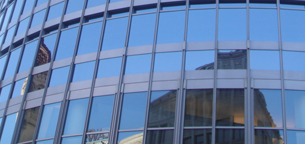
A corporate headquarters with an environmental control system
Example 5:
A home in a northerly climate
An energy efficient home in a northerly climate has four large southern exposed windows and two medium sized western exposed windows. The house relies on passive solar heating for part of its energy needs and consequently it is desired to allow the blinds to be fully open throughout the day and fully closed at night. This allows for maximum solar heat gains but reduces heat loss through the windows at night. In this case only one system was required. The sunlight sensor was placed on the eastern exposure so that the blinds would open at first light in the morning. Both the NIGHT CLOSE Enable and the SENSOR Enable are set to ON and the sensitivity adjustment is set to the least sensitive position.
After a period of time, it was felt that, although this setup allowed for the realisation of maximum solar heat gains, temperatures often climbed uncomfortably high when direct sunlight was strong through the southern windows.
To correct this, the system was adjusted: the sunlight sensor was placed on the southern exposure and the sensitivity was set slightly higher so that some strong direct sunlight was partially blocked by the system.
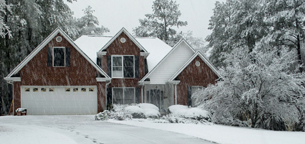
A home in a northerly climate
Example 6:
A home in a dry southern climate
A home in a southern, dry climate experiences high air conditioning costs due to its almost constant exposure to direct and intense sunlight throughout the day from its eastern, western and southern exposures. In addition, sunlight damage to expensive tapestries, furniture and paintings has been extensive. At night, external temperatures fall quite low in the desert-like climate, however the interior of the house can remain at a much higher temperature for many hours after nightfall.
To solve these problems, three smartBLIND systems were installed, one for each of the three east, west and southern exposures. Each system was set up in the same manner: the SENSOR Enable is set to ON and sensitivity is set very high to reduce the amount of incoming direct sunlight to a minimum; the NIGHT CLOSE Enable is set to OFF so that the blinds will be fully open at night which allows natural cooling of the house to take place.
This setup optimizes the daylighting conditions in the house throughout the day: all three systems open their blinds at daybreak, allowing pleasant soft lighting into the house; in the morning the eastern exposed system closes its blinds to block strong morning light, however ambient light is still permitted to enter the house through the southern and western exposures; as the day progresses, the southern exposed system will begin to close its blinds as the sun rises fully in the sky and concurrently, the eastern exposed system will begin to reopen its blinds as the strong direct sunlight gives way to softer ambient light; near the end of the day only the western exposed blinds will be closed to block the direct light coming in from that direction as the sun begins to set.
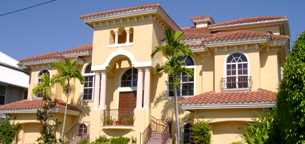
A home in a dry southern climate
Example 7:
A ground-floor apartment getting very little sunlight
A ground-floor apartment in a high density residential area of a city gets very little sunlight from its northern exposed bay window. The resident is a horticulturist and must make a choice. If she leaves her blinds open throughout the day to maximize the amount of light that her plants receive, then at night, before she returns from work, the interior of her apartment is quite visible to prying eyes from the outside street. She is forced to choose between her plants and her security.
To solve this dilemma a smartBLIND system is installed. To preserve the aesthetics of the bay window, five small blinds are required to match each of the facets of the window. The SENSOR Enable is set to OFF so that the blinds are fully open throughout the day and the NIGHT CLOSE Enable is set to ON so that the blinds will be fully closed by nightfall.
